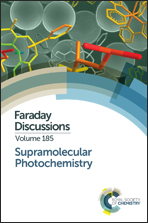Supramolecular bimetallic assemblies for photocatalytic hydrogen generation from water†
Abstract
A series of supramolecular assemblies of the type [Ru(L-L)2(L′-L)MX2)]n+ are reported where L-L is 2,2′-bipyridine (bipy), 4,4′-di-tetra-butyl-bipyridine (tbbipy) or 4,4′-diethoxycarbonyl-2,2′-bipyridine (dceb), L-L′ is tetrapyrido[3,2-a:2′,3′-c:3′′,2′′-h:2′′′,3′′′-j]phenazine (tpphz), 2,2′:5′,2′′-terpyridine (2,5-bpp), 2,2′:6′,2′′-terpyridine, (2,6-bpp), 2,5-di(pyridine-2-yl)pyrazine (2,5-dpp) or 2,3-di(pyridine-2-yl)pyrazine (2,3-dpp), and MX2 is PdCl2, PtCl2 or PtI2. The photocatalytic behaviour with respect to hydrogen generation of these compounds and their ultrafast photophysical properties are discussed as a function of the nature of the peripheral ligands, the bridging ligands and the catalytic centre. The results obtained show how differences in the chemical composition of the photocatalysts can affect intramolecular photoinduced electron transfer processes and the overall photocatalytic efficiency.
- This article is part of the themed collection: Supramolecular Photochemistry

 Please wait while we load your content...
Please wait while we load your content...